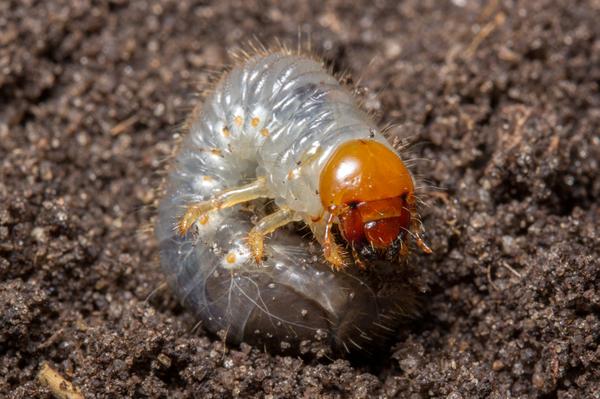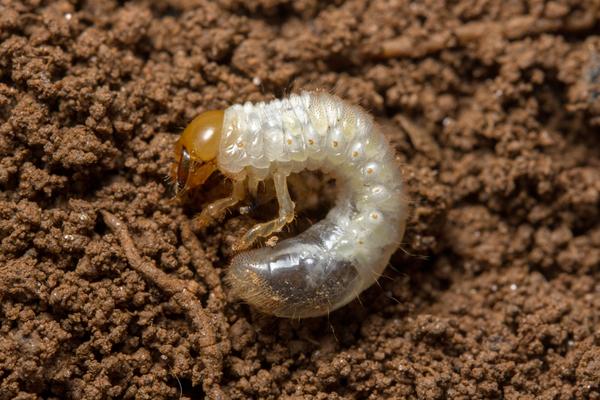Description
White grubs are the larvae of scarab beetles. The grubs of economic importance in North Carolina are those of the Japanese beetle, the green June beetle, the southern masked chafer, the northern masked chafer, May-June beetles and the Asiatic garden beetle. Several other species are also present but usually in low numbers. The Japanese beetle is consistently the most damaging grub in this state. Two relatively new pests, the turfgrass ataenius (on bluegrass) and the oriental beetle, are present in western North Carolina. These insects appear to be expanding their range and may become serious problems in the near future.
All these grubs have cream colored bodies with yellow to brownish heads, brownish hind parts, and six legs. Mature grubs vary in length from 1⁄4 to 11⁄2 inches, depending on the species. White grubs usually lie in a curled or C-shaped position. Billbug larvae may also be present but can be distinguished by the absence of legs.
Cultural Control
A biological treatment method, useful against only Japanese beetle grubs, is the application of milky spore bacteria. This commercially available bacteria, when applied to the soil, infects the grubs and produces a disease. Grubs in the soil come in contact with the spores through ingestion. The spores germinate inside the grubs, eventually killing them. These spores work best when applied in late September or early October to soil with a pH level between 6 and 7. The results are not as rapid as with chemical insecticides, but the effects last many years. When milky spore disease becomes established, it will spread naturally to adjoining, untreated areas. Application at the time of turf installation may result in a more uniform distribution of the spores in the soil. This product is available at many garden shops under such trade names as Doom®, Japidemic®, or Milky Spore.
Chemical Control
The timing of the insecticide application is critical if control is to be effective. There are two approaches, preventative and curative. Some of the newer products (Merit® and Mach 2®) are preventative, and are most effective when applied prior to when the eggs are laid. This approach should only be used in areas that have a history of grub infestations. The curative approach is used when an existing infestation is detected. The best time to apply curative insecticides is when the grubs are actively feeding near the soil surface. Pesticides applied any other time will be ineffective. This feeding occurs from August through October, and again in April through early May. Curative treatments applied in late summer or fall are usually more effective than spring applications because the grubs are small. Specific timing depends on the species of grub, and on location in the state. Timing of applications in the mountains will generally be later than in the eastern part of the state. Timing of applications for control of the turfgrass ataenius varies.
Another factor affecting chemical control is irrigation. Irrigation prior to application is highly recommended, especially in dry weather. Grubs stay deep in the soil when conditions are dry, and irrigation a day or two before application helps to bring them closer to the surface and improves control. Insecticides kill grubs more effectively if watered in after application. The only exception is carbaryl (Sevin) used to control green June beetles; it should not be watered in. After treatment, green June beetle grubs may be found on the soil surface, whereas other grub species will die in the soil.
No matter which product or approach is selected, be sure to follow label directions. Recommendations for insecticides approved for control of these insects in home lawns can be found under the white grubs listing in the North Carolina Agricultural Chemicals Manual. Recommendations for insecticides approved for use on sod farms, golf courses or other commercial sites can be found in the North Carolina Agricultural Chemicals Manual.
Recent studies indicate that traps for Japanese beetle adults have no real impact on the subsequent population of grubs in the soil. The use of Japanese beetle traps can also attract the foliage-feeding adults into areas where they may feed on ornamental landscape plants. Because environmental conditions, methods of application by growers, and performance of the chemicals may vary widely, control results may also vary. For additional information on insect control, timing and pesticide use contact your local Cooperative Extension center.
| Insecticide and Formulation | Amount per 1,000 sq ft | Precaution and Remarks |
|---|---|---|
| B.t.subspecies galleriae (grubGoneG) | 100-150 lbs/acre | |
| carbaryl* (Sevin) 80 WSP | 3 oz | |
| chlorantraniliprole (Acelepryn) | 0.184 to 0.367 fl oz | Optimal control when applied at egg hatch. Use higher rates later in summer. |
| chlorpyrifos* (Dursban) 50 WSP, Pro | See label | For use on golf courses; see new label. |
| clothianidin (Arena) .5G 50 WDG | 14 to 22 oz 0.15 to 0.22 oz | Mole cricket suppression. |
| chlothianidin + bifenthrin (Aloft) | See label | |
| chlothianidin + bifenthrin (Aloft) GC SC | 0.27 to 0.54 fl oz | |
| chlothianidin + bifenthrin (Aloft) LC SC | 0.27 to 0.54 fl oz | |
| chlothianidin + bifenthrin (Aloft) GC G | 1.8 to 3.6 lb | |
| chlothianidin + bifenthrin (Aloft) LC G | 1.8 to 3.6 lb | |
| imidacloprid* (Merit) 75 WP | 3 to 4 level tsp | Make application prior to egg hatch. (Offers some suppression of caterpillars.) |
| thiamethoxam (Meridian) 0.33 G 25 WG | 60 to 80 lb/acre 1 2.7 to 17 oz/acre | Optimum control when applied from peak flight of adults to peak of egg hatch. Also suppresses mole crickets and chinch bugs. |
| trichlorfon (Dylox, Proxol) 80 SP | 3.75 oz | Can be used with some success as a rescue treatment in August and September Apply at egg hatch |
| dinotefuran (Zylam) 20SG | 1 oz per 1,000 ft2 |
*Products in bold applicable to Green June beetles only.
References
- Carolina Lawns: A Guide to Maintaining Quality Turf in the Landscape. Miller, G. et al. 2016. NC Extension Publication AG-69.
- Effective Mole Control. Comer, G. L., Jr. and A. D. Rodewald. 2002. Ohio State University Extension FactSheet W-11-2002.
- Handbook of Turfgrass Insect Pests, Second Edition. Brandenburg, R.L. and C. P. Freeman. 2012. Entomological Society of America Latham, MD. 140pp.
- Identification of White Grubs in Turfgrass. Shetlar, D. J. and J. Andon. 2012.Ohioline, Ohio State University.
- 2018 Pest Control for Professional Turfgrass Managers. Bowman, D. et al. 2017. NC State Extension Publication AG-408. 81 pp.
- NC State Extension Plant Pathology Publications and Factsheets
- NC State Horticultural Science Publications
- North Carolina Agricultural Chemicals Manual
For assistance with a specific problem, contact your local Cooperative Extension Center
Publication date: Oct. 25, 2017
Reviewed/Revised: Aug. 31, 2022
Recommendations for the use of agricultural chemicals are included in this publication as a convenience to the reader. The use of brand names and any mention or listing of commercial products or services in this publication does not imply endorsement by NC State University or N.C. A&T State University nor discrimination against similar products or services not mentioned. Individuals who use agricultural chemicals are responsible for ensuring that the intended use complies with current regulations and conforms to the product label. Be sure to obtain current information about usage regulations and examine a current product label before applying any chemical. For assistance, contact your local N.C. Cooperative Extension county center.
N.C. Cooperative Extension prohibits discrimination and harassment regardless of age, color, disability, family and marital status, gender identity, national origin, political beliefs, race, religion, sex (including pregnancy), sexual orientation and veteran status.


